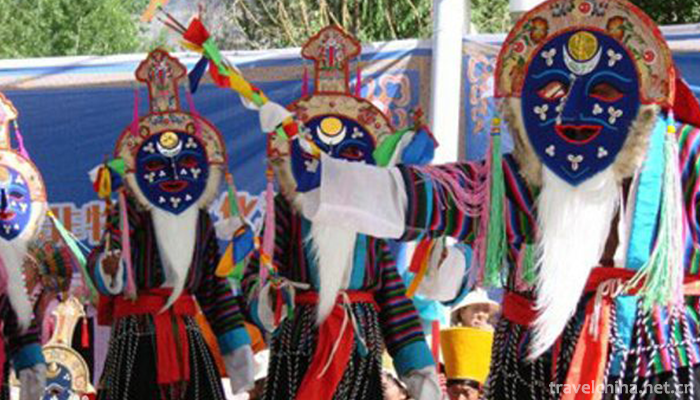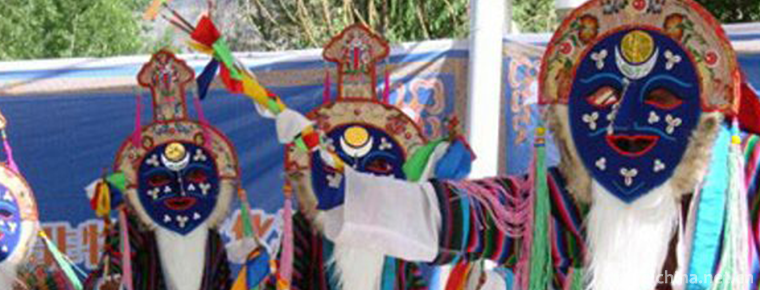Shannan Menba Opera
Shannan Menba Opera
Shannan Menba Opera, one of the national intangible cultural heritages, is a traditional drama in Lebu District, Kangna County, Shannan District, Tibet.
Because Shannan Menba Opera directly adopts Tibetan scripts of Tibetan Opera, it is called "Menba Aguiram" by the people, that is, Menba Tibetan Opera. Legend has it that at the end of the 18th century, Qiangbakelong brought back a Tibetan script of King Norsanfa from Lhasa, from which Shannan Menba Opera began to spread in Lebu. During the performance of Shannan Menba Opera, masked performers, accompanied by gongs and cymbals, interlace and alternate in speaking, singing and dancing, often producing shocking artistic effects. The lyrics are in the form of bulk ballads, and the tunes vary with the content and plot.
On May 20, 2006, Shannan Menba Opera was approved by the State Council of the People's Republic of China to be listed in the first batch of national intangible cultural heritage, numbered IV-81.
historical origin
- Pregnancy and formation
Shannan Menba Opera, known as "Menba Aguiram" by the people, is a unique cultural art created and developed by the people of Menba nationality in their long-term production and life. It is said that Shannan Menba Opera originated in the period of the 5th Dalai Lama. At that time, there was a village called "Yusongshading" in the corner of the gate, where there was a man named Luo Xincao. Because he had made great contributions to the development of production among the people at that time, the fifth Dalai Lama, in order to commend him for his achievements, collected Luo and took additional measures for his disciples, and let him go to Zhepeng Temple to study classics. When he finished his studies, he was honored as the "Mon Ba Meijao Lama, Luo Zai Cao". In 1680, the fifth Dalai Lama allocated additional funds to Luo, sent him back to the entrance to serve as Chief Executive, and at the same time allowed him to build the Dawang Temple. During the construction of the monastery, Luo collected and sorted out many local folktales and legends, and compiled the Tibetan opera "Zhuo Wa Sam" script.
The origin of Shannan Menba Opera is mainly the reward god singing and dancing. Its direct origin is the performance of Baqiang in religious sacrificial activities. By plotting it, a unique Menba Song and Dance Opera has been formed. Although influenced by Tibetan Opera, Shannan Menba Opera did not copy the model of Tibetan Opera, but digested and absorbed according to the aesthetic needs and psychology of the nation, making it an important part of Menba folk culture.
Rescue and protection period
Historically, Shannan Menba Opera was only circulated in the doorway areas, and there was no practice of performing in other areas. Until 1987, Shannan Menba Opera first appeared on the Lhasa Shelton Festival in Tibet. In 1986, the Shannan Menba Opera Troupe in Cuona County was restored when Lebu and Mama were founded, but faced with the loss of actors, the performance was terminated in 1991. In early 2007, with the support of the local government, Lexiang formally resumed organizing the Shannan Menba Opera Troupe. Six Lebu villagers and three Mama villagers jointly formed a nine-member theatre, and the actors were able to receive state subsidies. Now, there are seven performers in the traditional Shannan Menba Opera. There are two kinds of performances. One is complete. It takes at least one week for 18 small plays to finish. The other is compressed version. With the acceleration of people's life rhythm, the performers compressed and modified the program. They can finish the performance in one day. The simple Shannan Menba Opera has been normalized.
Representational repertoire
There are three main repertoires of Shannan Menba Opera: King Norsanfa, Zovasam and Araka. The first two are based on Buddhist mythology, and the last one is based on ancient mythology.
Inheritance and Protection
Inheritance value
Shannan Menba opera is one of the eight Tibetan operas in Tibet, and it is the historical tradition of the Menba nationality. Its main opera, King Norsanfa, is one of the oldest and most widely performed traditional operas in Tibetan opera.
Heritage figures
Gesang Danzeng, male, born in May 1970, is the representative successor of the second batch of state-level intangible cultural heritage projects, declared by the Tibet Autonomous Region. Declaration items: Shannan Menba Opera.
Bassan, male, born in October 1950, is the representative successor of the second batch of national intangible cultural heritage projects, declared by the Tibet Autonomous Region. Declaration items: Shannan Menba Opera.
protective measures
Sang Danzeng, who inherits his personality, is familiar with Shannan Menba Opera and is also the head of the village. He has appeal among the villagers and can motivate them to learn Shannan Menba Opera. His social activity ability is very strong, and he can obtain funds to maintain the daily training of Shannan Menba Opera Troupe and solve the problem of missed work fees for actors and learners.
In 2006, after Shannan Menba Opera was listed as China's first-class intangible cultural heritage, the relevant government departments in Tibet Autonomous Region and Shannan Region have attached great importance to the inheritance of Shannan Menba Opera.
Since 2007, the state and Tibetan local governments have invested 100,000 yuan in the protection of Shannan Menba Opera.
social influence
Important activities
On September 15, 2013, the Cangyang Jiacuo Love Song Cultural Tourism Festival in Tibet, with the theme of "Magic Mountain South of Tibetan Source, Love Gate Corner Lebu", opened in Lebugou, Kangna County, Shannan District, and Shannan Menba Opera was displayed on the spot.


-
1.Rabbit head
Rabbit head is a traditional snack in Sichuan Chengdu, Shanxi Datong and Zhejiang Quzhou.
Time 2018-10-13 -
2.Penglaige tourist area
Penglaige Scenic Area, located in Danya Mountain, northwest of Penglai City, Shandong Province, is a national AAAAA-level tourist attraction with an area of 18,500 square meters
Time 2018-12-08 -
3.Xinyingtai Eco Spa Resort
Yingtai Eco-Hot Spring Resort (Eco-Park) is located on the parallel road of Tengzhou City, Shandong Province. It is a comprehensive service enterprise integrating eco-catering
Time 2019-02-26 -
4.Red boxing
Red boxing originated in Zhou and Qin Dynasties, became famous in Tang and Song Dynasties and prevailed in Ming and Qing Dynasties. It is an important link
Time 2019-05-03 -
5.Lei opera
Lei Opera, formerly known as the Grand Opera Class, was once known as "Leizhou Opera" because of its early tune of Leizhou songs. It is one of the national intangible cultural heritage of Le
Time 2019-05-11 -
6.Running curtain
Running curtain originated in the Spring and Autumn Period and Warring States Period, formed in the Qin and Han Dynasties, flourished in the Song, Yuan, Ming, Qing Dynasty and the early Republic of Ch
Time 2019-06-09 -
7.Sheng Guanyue
The term "Sheng wind music" is not only a popular name in Chinese folk, but also a scientific name in the current academic circles. It refers to the orchestral performance form consisting of
Time 2019-06-14 -
8.Shizhu Tujia Luoer Diao
Shizhu Tujia Luoer Diao originated from Shizhu Tujia Autonomous County, Chongqing. It is a folk song of Luoer tune, which is popular among the Han and Tujia nationalities in southeastern Chongqing. It
Time 2019-06-15 -
9.Cave Building Techniques
Cave dwelling is an ancient dwelling form of residents on the Loess Plateau in Northwest China. The history of cave dwelling can be traced back to more than 4,000 years ago. The Chinese people creativ
Time 2019-07-11 -
10.North China Electric Power University
North China Electric Power University is a national key university directly under the Ministry of Education. It is a key construction University of "211 Project" and "985 Project Advant
Time 2019-09-22 -
11.Xiaoxiangling scenic spot
The synonym Xiaoxiangling generally refers to Xiaoxiangling scenic spot
Time 2020-10-16 -
12.Neijiang medical and health
By the end of 2019, there are 3303 medical and health institutions in Neijiang, including 76 hospitals (56 private hospitals) and 3200 primary medical and health institutions. There are 25900 beds in medical and health institutions and 21100 health technical personnel,
Time 2020-12-16